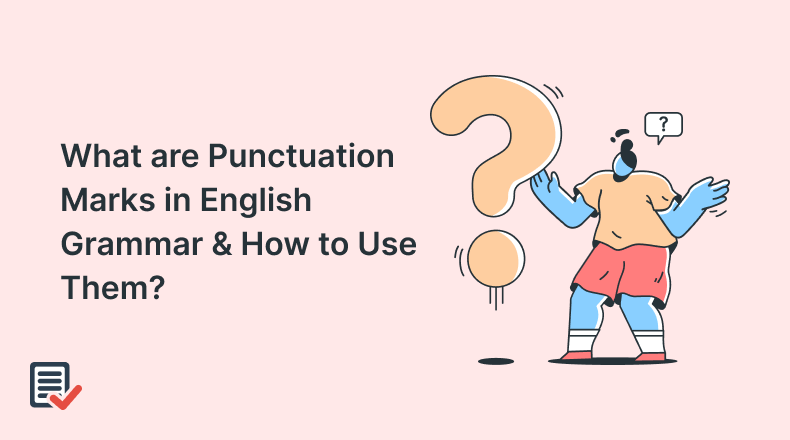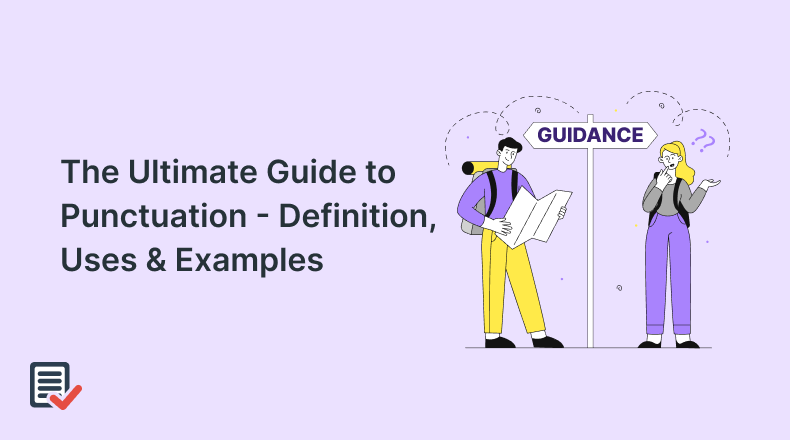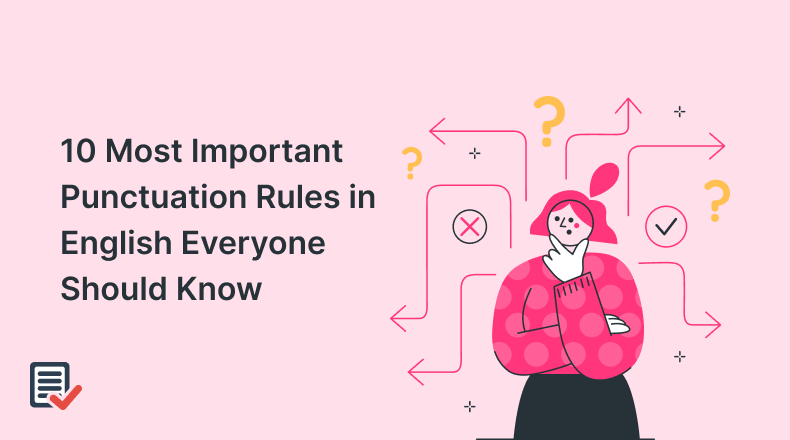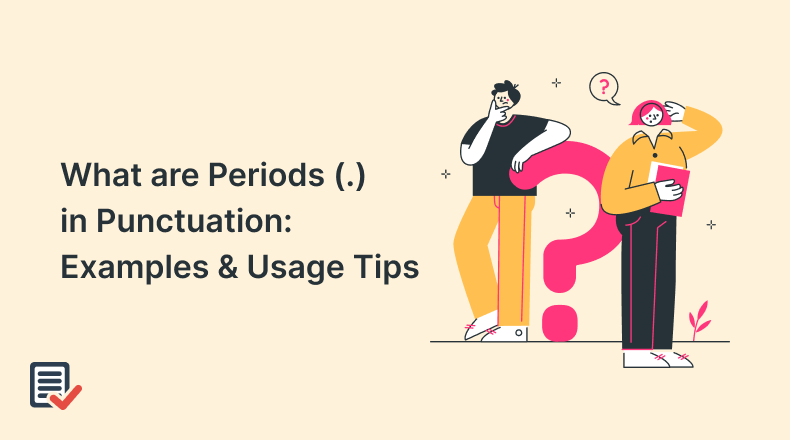
Punctuation marks are one of the basic lessons taught in school, however, these often become annoying when writing or editing. Even if you intend to avoid them, there might still be some ways your content could have punctuation errors. Whether you are new to learning the English language or just revisiting the punctuation concepts, this blog will help you understand which punctuation symbol goes where and why.
What are Punctuation Marks?
Punctuation marks are different symbols used in language with different purposes. They are essential for effective communication, enhanced clarity, and coherence to ensure that the message of the content is clarified and is in a proper structure. In simpler words, punctuation is the building block of writing. Punctuation marks help readers interpret the intended message and flow of ideas effectively.
How to Use Punctuation Marks?
There are many punctuation marks in English grammar that are used in different contexts. However, it is essential to be familiar with these symbols to write effectively.
Here is a list of commonly used punctuation marks in the English language that you must know to make your content flawless.
1. Period (.)
Denoted by a dot, this punctuation mark is called a period or full stop (.). A period indicates the end of a sentence, separates different statements, and provides a natural pause for the reader. Full stop or period is also used in abbreviations and certain numerical expressions.
Examples:
- She enjoys reading historical novels.
- The meeting is scheduled for 10 a.m.
- The score was 4.5 out of 5.
2. Comma (,)
The comma is used to separate elements and indicate a pause in a sentence. Commas organize elements in a sentence by making them easier to read and understand. They can also distinguish between independent and dependent clauses. Misplacing or excluding commas can lead to confusion.
Examples:
- “Mom needs to buy apples, oranges, bananas, and grapes.”
- “Kira wanted to go for a walk, but it started raining.”
- “After dinner, we watched a movie.”
- “My grandpa, who lives in New York, is visiting this weekend.”
- “It was a long, tiring day.”
3. Question Mark (?)
The question mark (?) is used at the end of a sentence to indicate that the sentence is a question. It signals to the reader that an inquiry is being made. Question marks are only used in interrogative or rhetorical sentences.
Examples:
- “What time does the meeting start?”
- “Isn’t it a beautiful day?”
- “Could you please pass the salt?”
- “Are you coming to the party tonight?”
- “You finished your homework, right?”
4. Exclamation Mark (!)
Exclamation mark is a punctuation mark used to indicate strong emotions, surprise, excitement, anger, or emphasis. Exclamation marks allow the reader to understand that the sentence has intense emotions.
Examples:
- “Hurry up!”
- “Let’s go!”
- “Hurrah!”
5. Colon (:)
The colon (:) is a punctuation mark used for explanation. It signals that the following text is directly related to the previous clause in detail.
Examples:
- “You will need the following ingredients for the recipe: flour, sugar, eggs, and butter.”
- “The author stated his main argument clearly: ‘The impact of climate change is undeniable.'”
- “She had one goal in mind: to win the championship.”
- “He had a clear vision for the project: to innovate and inspire.”
6. Semicolon (;)
The semicolon (;) is a punctuation mark that serves as a connector between related independent clauses. It indicates a pause that is longer than a comma but shorter than a period. Additionally, it can be used to separate items in a complex list where commas are already present.
Examples:
- “I have a big exam tomorrow; I can’t go out tonight.”
- “On our trip, we visited Paris, France; Rome, Italy; and Berlin, Germany.”
7. Quotation Marks (” “)
Quotation marks (” “) are used to indicate direct speech, quotations, titles of articles, poems, songs, etc. They distinguish quotes from the rest of the text, allowing readers to understand when someone is speaking or when something is being referenced.
Examples:
- Helena said, “I will be late to the meeting.”
- The author wrote, “To be yourself in a world that is constantly trying to make you something else is the greatest accomplishment.”
- Miranda just finished reading “The Road Not Taken” by Robert Frost.
8. Apostrophe (‘)
The apostrophe (‘) is used to indicate possession and to form a contraction. In the context of possession, the apostrophe is placed before the “s” for singular nouns and after the “s” for plural nouns. In contractions, the apostrophe combines words for a conversational flow in written content.
Examples:
- Contraction:
I can’t believe it’s already Friday! (I cannot believe it is already Friday.)
- Possession:
The teachers’ lounge is on the second floor. (The lounge belongs to multiple teachers.)
The cat’s toy is under the couch. (The toy belongs to the cat.)
9. Hyphen (-)
The hyphen (-) connects words or parts of words, compound adjectives, and breaks words at the end of a line. Hyphen creates cohesion and precision, helping to avoid ambiguity. Hyphen is also used in certain numerical ranges.
Examples:
- Well-known (“Jane Austen was a well-known author.”)
- Mother-in-law (“Samuel is visiting his mother-in-law this weekend.”)
- Twenty-five (“The event will start at twenty-five past three.”)
- 13-20 (“The brand offers clothes for kids between 13-20 of age.”)
- Self-esteem (“Building self-esteem is important for personal growth.”)
10. Dash (—)
The dash (—), often referred to as the em or en dash, creates emphasis, indicates interruptions, or sets apart information in a sentence. It can replace commas, parentheses, or colons. The em dash adds a dramatic pause or a strong emphasis, while the en dash is used in ranges.
Examples:
- I can’t believe she said that—it was completely unexpected.
- The meeting—originally scheduled for Thursday—has been postponed.
- 10-20 Years
- 15-20%
11. Parentheses ()
Parentheses (()) are punctuation marks used to enclose additional information that is not essential for the essence of a sentence. Even if the information within parentheses is removed, the sentence should still make sense. Parentheses can be used for a variety of purposes, including citing sources, providing examples, or explaining a term.
Examples:
- The book (which was published in 2020) received rave reviews from critics.
- Many studies show the benefits of regular exercise (Smith, 2019).
- The committee will meet next week (on Wednesday) to discuss the budget.
- Our team consists of experts in various fields (such as marketing, design, and engineering).
12. Brackets ([ ])
Brackets ([ ]) are used in writing to enclose additional information, clarifications, or explanatory notes that aren’t included in the main text. Brackets can add context without disrupting the flow of the original sentence. In academic writing, brackets are used to clarify a quote or citation by adding information.
Examples:
Clarification in Quotes:
– Original quote: “He was a great composer.”
– Revised: “He [Beethoven] was a great composer.”
Explanatory Note:
– “The results of the study [conducted in 2006] were significant.”
Indicating Changes:
– “Martha said she would [try to] finish the report by tonight.”
In Lists:
– “The three primary colors are red, blue, and yellow [in terms of pigment].”
13. Ellipses (…)
Ellipses, also called three consecutive dots (…), indicate the omission of words, a pause in speech, or an unfinished thought. In writing, ellipses can create suspense, suggest hesitation, or indicate that a thought faded. In quotations, ellipses show that text has been omitted without alteration.
Examples:
- Omission of Words: “I would like to go to the mall, but…”
- Unfinished Thought: “Perry was thinking that maybe she could…”
- Creating Suspense: “Alex walked into the room and saw something he never expected…”
- In Quotations: “The results of the experiment were inconclusive… further research is needed.”
14. Slash (/)
Slash (/), also called titled line, is used to indicate alternatives and separate items. In mathematics, slash denotes division. In choices, Slash represents “or” as in “and/or”. It is also commonly used in abbreviations (e.g., “w/o” for “without”) and web addresses (URLs).
Example:
- “You can choose to pay by debit/credit card.”
- “The recipe calls for 1/2 cup of sugar.”
- “Please submit your report w/o delay.”
- “Visit our website at www.example.com/contact.”
15. Ampersand (&)
This typographic symbol is called the ampersand (&) and represents the word “and.” Ampersand is often used in informal writing, brands, and to save space by creating visually appealing text. Ampersand connects two or more items in a list or a phrase. It also makes any text look concise and elegant, however, its use is dependent on the context.
Example:
– List: “Peanut Butter & Jelly Sandwich”
– Brand: “Johnson & Johnson”
– Title: “Beauty & the Beast”







